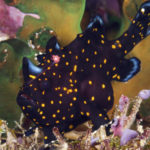
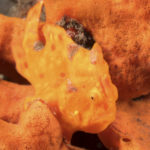
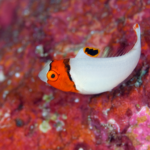
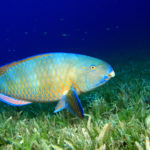
The reefs around Wakatobi Dive Resort are home to a colorful menagerie of tropical fish. Although many seem quite vivid to our eyes, they actually match the reef environment quite well when another fish is looking at them. Rather than standing out, their colors serve as camouflage from both predators and potential prey. This colorful camouflage can offer divers hours of enjoyment as they seek to identify a particular species. And to add to the challenge, many fish change appearance dramatically as they mature. In the undersea world, stripes, spots and entire body colors will appear, fade or morph as these fish turn from juveniles to adults.
Juvenile frogfish like this one can be as small as a grape.
Why do fish change appearance as they age?
Fish change colors and patterns as they mature for several reasons. Juveniles growing up in one environment, such as a seagrass bed or mangrove estuary, may be perfectly camouflaged for their surroundings. But when they mature and move to a different environment, such as a reef, they may have to change color and pattern. The second reason for a color change with age may be to avoid conflict. As they grow up, juveniles will likely share space with adults of their own species. This could lead to territorial conflicts that the little guys would lose. So, by appearing to be an entirely different species, the chances of a turf war diminish.
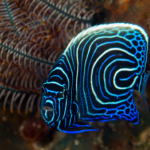
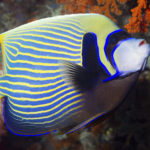
The emperor angelfish
The juvenile emperor angelfish, for example, which ranges from the size of a dime to the diameter of your palm, looks like a child of the 1960s, with psychedelic electric blue swirls and alternating pale blue lines. Because these color patterns differ so wildly from an adult’s, even marine biologists previously thought the youngsters were a different species. But in reality, over a period of 24 to 30 months, a series of distinct blue and yellow stripes emerges and covers most of the fish’s body. To our eyes, these stripes stand out in vivid contrast, but at greater distances the stripes may help to disrupt the fish’s outline and camouflage it from ever-present predators. The dark band of color across the emperor’s nose helps obscure the fish’s eyes and confuses the predator as to which end is which. This misdirection might help the fish escape if the attacker guesses wrong.
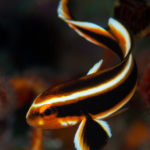
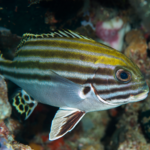
The juvenile sweetlips
The colors and patterns of coral-reef fish are unexpectedly malleable. Some change color gradually with season or age. Others can alter their appearance almost instantaneously to blend into their surroundings, or to display their current emotional state. The striped sweetlips are among the slow changers, but they do undergo a startling transformation from juvenile to adult. As a juvenile, the sweetlips is a colorful gem, but as it matures, flamboyance gives way to stripes. These bold black and white markings, while attractive to divers and photographers, also serve as a defense mechanism. The stripes disrupt the fish’s outline, making it difficult for predators to isolate and attack an individual within a moving school.
The wrasse family
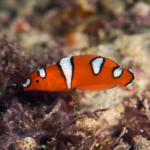
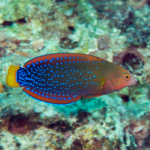
Members of the wrasse family undergo some of the most dramatic changes between their juvenile and adult stages. These changes can play an important role in social organization. Like many coral-reef fishes, wrasses change sex throughout their lives and their coloration usually changes when this occurs, signaling their gender to other members of their species. One example is the yellowtail coris. These small red-orange fish with bright white accents are common on reefs around Wakatobi, and when you spot one, you might think you’ve found Nemo. But any resemblance to the famous clownfish is purely coincidental.
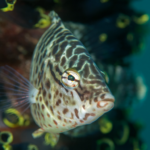

With age, the yellowtail coris will come into its own, transforming not once, but twice, as it matures. As a teenager, the body coloration changes from red-orange to green. Blue spots running down the rear portion of the body and orange accents along the dorsal and bottom anal fins and across the face replace the white bands. When fully grown, the yellowtail coris can reach lengths of a foot or more. Fish close to this size are typically males, and thus begin their final transformation, developing a bright yellow to green mid-body bar that identifies the fish as a terminal male, meaning he’s a dominant spawner. Lesser males tend to have duller coloration and aren’t as likely to attract spawning partners. Proof, perhaps, of the benefits of being a sharp dresser.
For some fish on Wakatobi’s reefs, age represents a retreat from the flamboyance of youth to the more mundane hues of adulthood. But for others, maturity brings out new and brighter patterns. Let’s hope we can follow the ways of the latter group as we move into our well-earned golden years.
By Karen Stearns
The post Juveniles on the Reef at Wakatobi Dive Resort appeared first on Scuba Diver Life.
from Scuba Diver Life http://ift.tt/2BCa7Wg
No comments:
Post a Comment